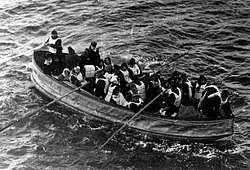
Back بەلەمە ڕزگارکەرەکانی تایتانیک CKB Botes salvavidas del RMS Titanic Spanish Canots de sauvetage du Titanic French Lance di salvataggio del Titanic Italian Botes salva-vidas do RMS Titanic Portuguese Záchranné člny na RMS Titanic Slovak Reševalni čolni ladje RMS Titanic Slovenian 鐵達尼號救生艇 Chinese


Lifeboats played a crucial role during the sinking of the Titanic on 14–15 April 1912. The ship had 20 lifeboats that, in total, could accommodate 1,178 people, a little over half of the 2,209 on board the night it sank. 18 lifeboats were used, loading between 11:45 P.M. and 2:05 A.M., though Collapsible Boat A floated off the ship's partially submerged deck and Collapsible Boat B floated away upside down minutes before the ship upended and sank.
Many lifeboats only carried a fraction of their maximum capacity which, depending on type, was 40, 47, or 65 people. There are many versions as to the reasoning behind half-filled lifeboats; these included the order of "women and children first", apprehensions that the lifeboats could buckle under the weight, and the fact that many passengers did not feel safe stepping in a lifeboat hovering 90 feet above the freezing ocean and others refused to leave behind family and friends. As the half-filled boats rowed away from the ship, they were too far away for other passengers to reach, and most lifeboats did not return to the wreck due to a fear of being swamped by drowning victims or the suction of the sinking ship. Only Lifeboats No. 4 and No. 14 returned to retrieve survivors from the water, some of whom later died.
Although the number of lifeboats was insufficient, Titanic complied with maritime safety regulations at the time and even went over regulations by adding four collapsibles. The sinking showed that the regulations were outdated for such large passenger ships. In the event of an emergency, it was not anticipated that all passengers and crew would require evacuation at the same time; it was believed that Titanic could float long enough to allow a transfer of passengers and crew to a rescue vessel. Additionally, even if the ship did have more lifeboats, due to the laborous task of launching lifeboats using davits, there was only enough time to launch all but two boats before the ship began its final plunge.
A total of 1,503 people lost their lives when the Titanic sank in the North Atlantic Ocean. Many of them had not made it into a boat. Only 706 people survived in the lifeboats until later that morning when they were rescued by the RMS Carpathia. Those aboard the lifeboats were picked up by Carpathia over the course of 4 hours and 30 minutes, from about 4 A.M. to 8:30 A.M., and 13 of the lifeboats were also taken aboard. The lifeboats were returned to the White Star Line at New York Harbor, as they were the only items of value salvaged from the shipwreck, but subsequently vanished from history over time.